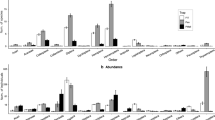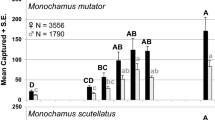Abstract
Fire-favoured insects are difficult to sample except opportunistically after forest fires. Here, we tested if smoke from a small fire could be an efficient way to sample such insects. Insects were sampled over ca. 10 h hours, by hand-picking and netting on screens put up around the fire. Two specimens of the rare and redlisted Hormopeza spp. (Diptera, Empididae) were caught. Large numbers (>20,000) of Microsania spp. (Diptera, Platypezidae) were caught, but none in the absence of smoke. The numbers of Microsania spp. clearly peaked in late afternoon, and a short sampling period would be sufficient if targeting only this taxon. Of the almost 200 species of Coleoptera, 17 % were considered as fire-favoured, contributing 9 % of the specimens, suggesting low efficiency of the method for this group. Using 23 sites differing in fire history, catches of Microsania spp. were unaffected by numbers and area of forest fire (preceding 5 years and within 10 km radius over the sampling sites). In contrast, there was a weak trend for the proportion of fire-favoured Coleoptera to increase with increasing number of fires. To conclude, smoke as produced in our study can clearly attract fire-favoured Diptera, but smoke had only a weak effect on fire-favoured Coleoptera in the study area. It is still likely that selectively picking specimens of species attracted to smoke is a more cost-efficient method than using, e.g., Malaise traps that catch indiscriminately.




Similar content being viewed by others
References
Ahnlund H, Viklund B, Wikars L-O (2006) Insekterna. I: Pettersson U (ed) Branden i Tyresta 1999. Dokumentation av effekterna. sid. 81–107. Naturvårdsverket. Dokumentation av de svenska nationalparkerna nr. 20 (in Swedish)
Amaral SS, de Carvalho Junior JA, Costa MAM, Neto TGS, Dellani R, Leite LHS (2014) Comparative study for hardwood and softwood forest biomass: chemical characterization, combustion phases and gas and particulate matter emissions. Bioresour Technol 164:55–63
Andersson K, Bergman K-O, Andersson F, Hedenström E, Jansson N, Burman J, Winde I, Larsson MC, Milberg P (2014) High-accuracy sampling of saproxylic diversity indicators at regional scales with pheromones: the case of Elater ferrugineus (Coleoptera, Elateridae). Biol Conserv 171:156–166
Ångström-Balla G (2006) Skogsbränder i Östergötland—frekvens, substratsbildning samt analys av brandberoende skalbaggars möjlighet att överleva. Undergraduate thesis in biology, Department of Physics and Measurement Technology, Linköping University, LiU-IFM-Biol-Ex-8/1899-SE (in Swedish)
Artdatabanken (2009a) Artfakta—Hormopeza copulifera. http://www.artfakta.se/Artfaktablad/Hormopeza_Copulifera_232161.pdf (in Swedish). (Accessed 1 May 2012)
Artdatabanken (2009b) Artfakta—Hormopeza obliterata. http://www.artfakta.se/Artfaktablad/Hormopeza_Obliterata_101083.pdf (in Swedish). (Accessed 1 May 2012)
Brown KJ, Giesecke T (2014) Holocene fire disturbance in the boreal forest of central Sweden. Boreas 43:639–651
Brues CT (1950) Vespid wasps (Eumenes curvata) attracted to smoke. Psyche 57:114–115
Chandler PJ (1978) Some dipterous opportunists at Windsor Forest, Berks: the attractions for flies of bonfires, wood ash and freshly cut logs. Entomol Gaz 29:253–257
Cox DR, Snell EJ (1989) Analysis of binary data, vol 32. CRC Press, Boca Raton
Evans WG (1966) Perception of infrared radiation from forest fires by Melanophila acuminata de Geer (Buprestidae, Coleoptera). Ecology 47:1061–1065
Forsslund A, Johansson N, Hedin J, Johansson T, Jansson N, Nordlind E (2011) Brandgynnade arter i sydöstra Sverige. Länsstyrelsen Kalmar Län, Länsstyrelserna Meddelande nr 2011:16. 90 p (in Swedish)
Glas AS, Lijmer JG, Prins MH, Bonsel GJ, Bossuyt PM (2003) The diagnostic odds ratio: a single indicator of test performance. J Clin Epidemiol 56:1129–1135
Gonçalves C, Alves C, Evtyugina M, Mirante F, Pio C, Caseiro A, Schmidl C, Bauer H, Carvalho F (2010) Characterisation of PM10 emissions from woodstove combustion of common woods grown in Portugal. Atmos Environ 44:4474–4480
Granström A (2001) Fire management for biodiversity in the European boreal forest. Scand J For Res 16(S3):62–69
Granström A, Schimmel J (1993) Heat effects on seeds and rhizomes of a selection of boreal forest plants and potential reaction to fire. Oecologia 94:307–313
Hjältén J, Gibb H, Ball JP (2010) How will low-intensity burning after clear-felling affect mid-boreal insect assemblages? Basic Appl Ecol 11:363–372
Ingvarson K, Rova J, Forsslund A, Borehag M, Unell M, Nordlind E (2012) Strategi för naturvårdsbränning i sydöstra Sveriges skyddade skogsområden år 2012-2022. Bakgrund, analys och genomförande. Länsstyrelserna Meddelande nr 2012:13. 72 p (in Swedish)
Jefferson LV, Pennacchio M, Havens-Young K (2014) Ecology of plant-derived smoke: its use in seed germination. Oxford University Press, Oxford
Johansson T, Hjältén J, Stenbacka F, Dynesius M (2010) Responses of eight boreal flat bug (Heteroptera: aradidae) species to clear-cutting and forest fire. J Insect Conserv 14:3–9
Johansson T, Andersson J, Hjältén J, Dynesius M, Ecke F (2011) Short-term responses of beetle assemblages to wildfire in a region with more than 100 years of fire suppression. Insect Conserv Diver 4:142–151
Johansson T, Hjältén J, de Jong J, von Stedingk H (2013) Environmental considerations from legislation and certification in managed forest stands: a review of their importance for biodiversity. For Ecol Manag 303:98–112
Kistler M, Schmidl C, Padouvas E, Giebl H, Lohninger J, Ellinger R, Bauer H, Puxbaum H (2012) Odor, gaseous and PM10 emissions from small scale combustion of wood types indigenous to Central Europe. Atmos Environ 51:86–93
Klocke D, Schmitz A, Schmitz H (2011) Fire-adaptation in Hypocerides nearcticus Borgmeier and Anabarhynchus hyalipennis hyalipennis Marquart and new notes about the Australian “smoke fly” Microsania australis Collart (Diptera: phoridae, Therevidae and Platypezidae). Open Entomol J 5:10–14
Lundberg S (1984) The beetle fauna of burnt forest in Sweden. Entomol Tidskr 105:129–141
Lundberg S (1995) Catalogus coleopterorum Sueciae. Naturhistoriska Riksmuseet, Stockholm
Milberg P, Bergman K-O, Johansson H, Jansson N (2014) Low host-tree preferences among saproxylic beetles: a comparison of four deciduous species. Insect Conserv Divers 7:508–522
Musa N, Andersson K, Burman J, Andersson F, Hedenström E, Jansson N, Paltto H, Westerberg L, Winde I, Larsson MC, Bergman K-O, Milberg P (2013) Using sex pheromone and a multi-scale approach to predict the distribution of a rare saproxylic beetle. PLoS One 8(6):e66149
Niklasson M, Granström A (2000) Numbers and sizes of fires: long-term spatially explicit fire history in a Swedish boreal landscape. Ecology 81:1484–1499
Niklasson M, Zin E, Zielonka T, Feijen M, Korczyk AF, Churski M, Samojlik T, Jędrzejewska B, Gutowski J, Brzeziecki B (2010) A 350-year tree-ring fire record from Białowieża Primeval Forest, Poland: implications for Central European lowland fire history. J Ecol 98:1319–1329
Ohsawa M (2010) Beetle families as indicators of Coleopteran diversity in forests: a study using Malaise traps in the central mountainous regions of Japan. J Insect Conserv 14:479–484
Pettersson RB , Ball JP (2011) Anlockningsbrand för rökdansfluga (Hormopeza obliterata Zett.) i Västerbottens län 2006. In: Pettersson RB (ed) Inventeringar av brandgynnade insekter i Västerbottens län 2005-2006. Länsstyrelsen Västerbotten Meddelande nr 8, pp 65–75 (in Swedish)
Ranius T, Jansson N (2002) A comparison of three methods to survey saproxylic beetles in hollow oaks. Biodiv Conserv 11:1759–1771
Ranius T, Bohman P, Hedgren O, Wikars L-O, Caruso A (2014) Metapopulation dynamics of a beetle species confined to burned forest sites in a managed forest region. Ecography 37:797–804
Risberg L, Granström A (2012) Seed dynamics of two fire-dependent Geranium species in the boreal forest of southeastern Sweden. Botany 90:794–805
Saint-Germain M, Drapeau P, Buddle CM (2008) Persistence of pyrophilous insects in fire-driven boreal forests: population dynamics in burned and unburned forests. Diver Distrib 14:713–720
Schütz S, Weissbecker B, Hummel HE, Apel KH, Schmitz H, Bleckmann H (1999) Insect antenna as a smoke detector. Nature 398:298–299
Sinclair BJ, Cumming JM (2006) The morphology, higher-level phylogeny and classification of the Empidoidea (Diptera). Zootaxa 1180:1–172
Snoddy E, Tippins H (1968) On the ecology of a smoke fly, Microsania imperfect. Ann Entomol Soc Am 61:1200–1201
Sullivan BT, Fettig CJ, Otrosina WJ, Dalusky MJ, Berisford CW (2003) Association between severity of prescribed burns and subsequent activity of conifer-infesting beetles in stands of longleaf pine. For Ecol Manag 185:327–340
Wikars L-O (1992) Forest fires and insects. Entomol Tidskr 113:1–11
Wikars L-O (1997) Pyrophilous insects in Orsa Finnmark, Central Sweden: biology, distribution, and conservation. Entomol Tidskr 118:155–169
Wikars L-O (2002) Dependence of fire in wood-living species: an experiment with burned and unburned spruce and birch logs. J Insect Conserv 6:1–12
Wikars L-O (2006) Åtgärdsprogram för bevarande av brandinsekter i boreal skog. Naturvårdsverket Rapport 5610, 78 pp. http://www.naturvardsverket.se/Om-Naturvardsverket/Publikationer/ISBN/5600/91-620-5610-7/
Ylisirniö A-L, Penttilä R, Berglund H, Hallikainen V, Isaeva L, Kauhanen H, Koivula M, Mikkola K (2012) Dead wood and polypore diversity in natural post-fire succession forests and managed stands: lessons for biodiversity management in boreal forests. For Ecol Manag 286:16–27
Zackrisson O (1977) Influence of forest fires on the North Swedish boreal forest. Oikos 29:22–32
Acknowledgments
We thank Rickard Andersson and Stig Lundberg (identification of Coleoptera), Ingemar Struwe (identification of Dipteria), Usman Muhammadi (help in the laboratory), Klas Andersson (fire data), Fia Sundin (GIS data), and Linnea Norman (illustration). Financial support was provided by the County Administrative Board of Östergötland.
Author information
Authors and Affiliations
Corresponding author
Rights and permissions
About this article
Cite this article
Milberg, P., Bergman, KO., Norman, H. et al. A burning desire for smoke? Sampling insects favoured by forest fire in the absence of fire. J Insect Conserv 19, 55–65 (2015). https://doi.org/10.1007/s10841-014-9742-5
Received:
Accepted:
Published:
Issue Date:
DOI: https://doi.org/10.1007/s10841-014-9742-5




